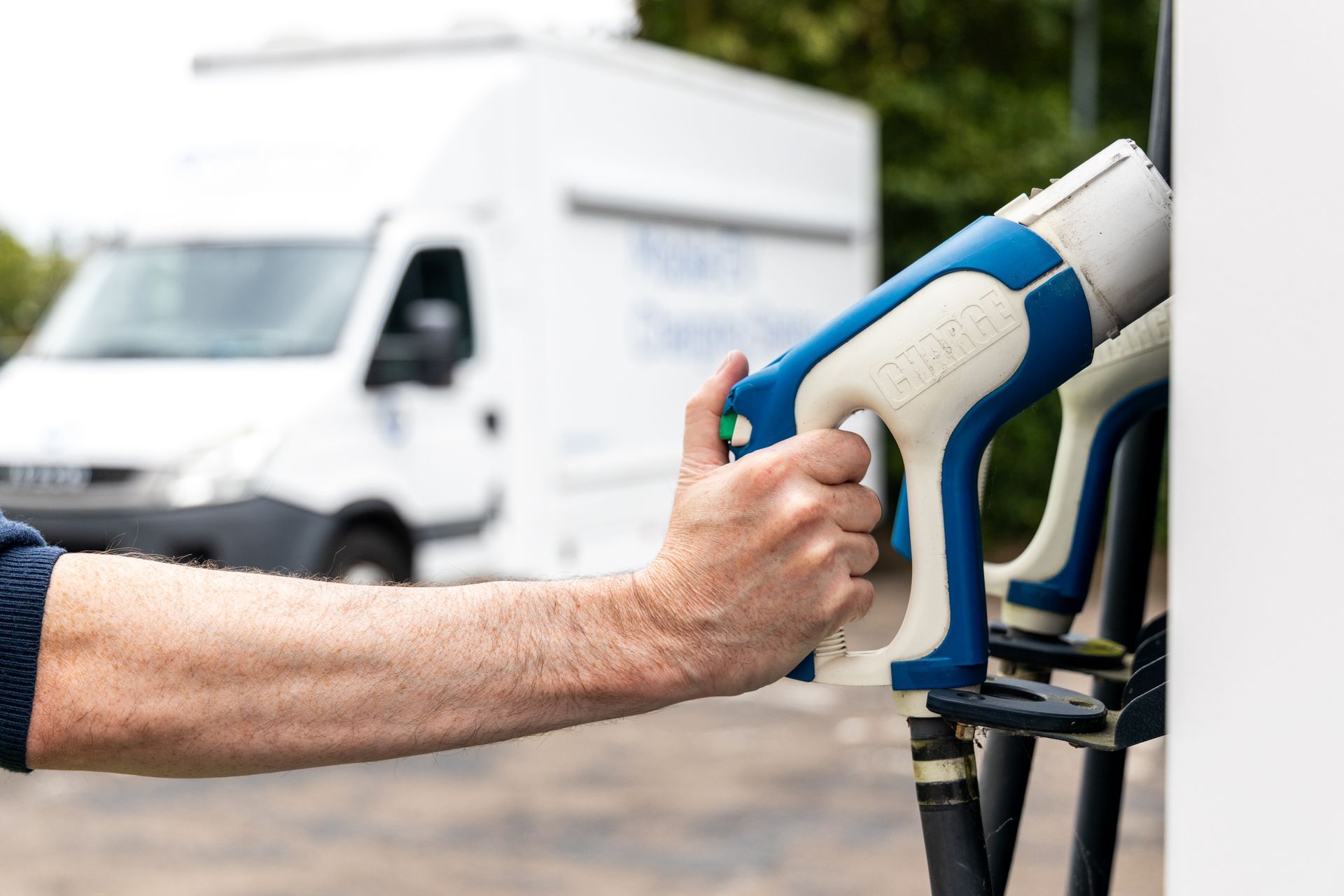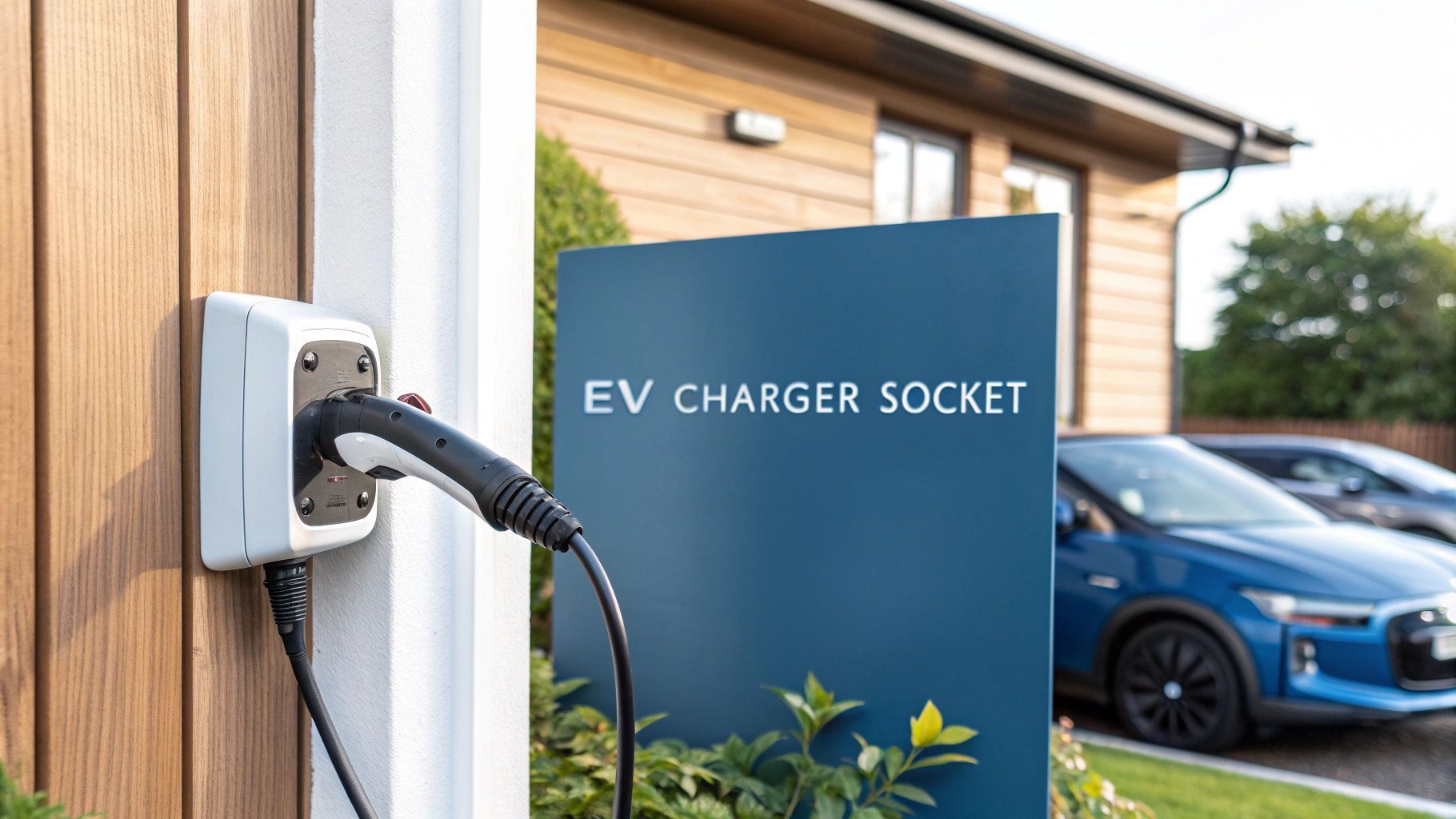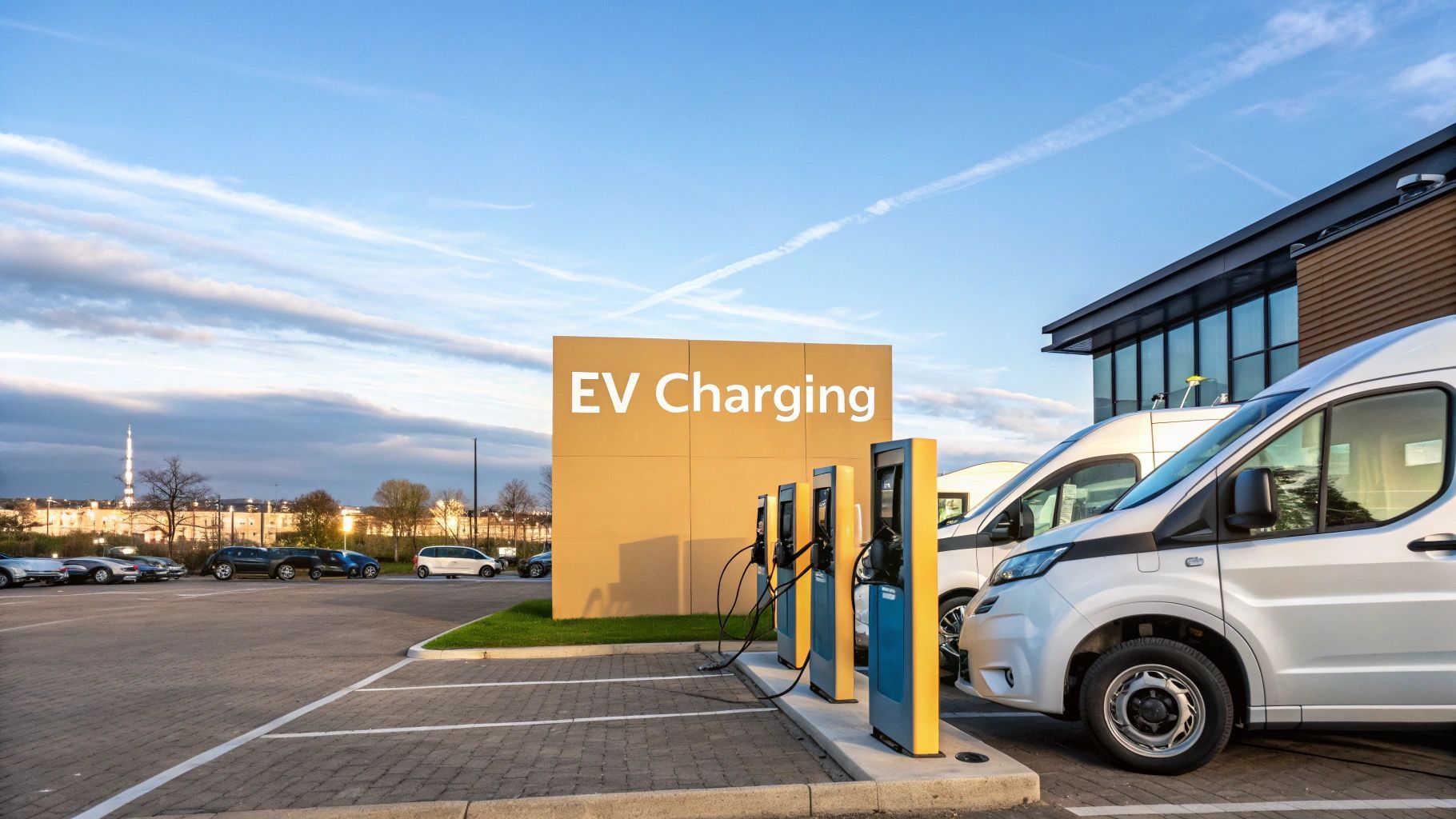Mastering Electric Vehicle Fleet Management in the UK
Managing a fleet of electric vehicles is more than just swapping diesel for electricity. It's a whole new way of thinking. At its heart, electric vehicle fleet management is about smartly coordinating your EVs and charging points to run as efficiently as possible, cut costs, and hit your business targets. This means moving on from simply managing fuel cards and embracing a system built around smart charging, data, and proactive maintenance. It turns a standard fleet into a finely tuned, high-performance operation.
The Electric Tipping Point for UK Fleets

For UK commercial fleets, going electric isn't some far-off idea anymore. It's happening right now, driven by real-world financial and operational advantages. Forward-thinking managers now see electric vehicle fleet management as a core business strategy. The conversation has shifted from just "being green" to gaining a competitive edge, building a more resilient operation, and achieving serious cost savings.
This isn't just about replacing a few vans. It’s a complete operational overhaul. To succeed, you need a fresh approach that weaves together smart charging schedules to take advantage of cheap off-peak energy, data-rich telematics to keep an eye on vehicle health, and maintenance plans designed for the unique needs of EVs.
Embracing a New Operational Model
Adopting electric vehicles brings a new set of challenges, but also a new world of opportunities. The UK's EV fleet is growing incredibly fast, with more than 1,145,000 fully electric cars on the road by the middle of the year. Much of this growth is being driven by fleet buyers who are making the strategic switch to hit sustainability goals and benefit from government tax incentives. You can dig deeper into these EV statistics on The Eco Experts.
This rapid adoption means businesses can't afford to wait. Getting the management right is what unlocks the true power of an electric fleet. It all comes down to asking the right questions about how you manage your energy, your data, and your vehicle uptime.
The real game-changer in modern electric vehicle fleet management is treating energy as a controllable asset, not just another running cost. By controlling when and how your vehicles charge, you can slash your operational spending.
Beyond Fixed Charging Points
A modern, profitable fleet cannot be tethered to depot-based charging alone. Advanced software and flexible solutions like mobile charging are becoming non-negotiable. These are not just nice-to-have extras; they are the building blocks of an efficient operation that can keep up with today's dynamic demands.
Mobile charging, especially, solves common headaches like not having enough power at the depot or needing a quick top-up during a busy shift. It keeps your vehicles on the road making money, not sitting idle waiting for a charging bay to free up. This guide will unpack how these technologies form the backbone of a future-proof, profitable fleet.
The Three Pillars of Smart EV Fleet Operations

Running an electric fleet isn't just about swapping diesel vans for electric ones. It's about building a finely tuned system where vehicles, energy, and data work in perfect harmony. To get this right, your electric vehicle fleet management strategy needs to be built on three core pillars.
Get these right, and the transition to electric becomes a straightforward path to a more profitable and reliable operation. They are not standalone concepts, either. Each one feeds into the others, creating a constant loop of information that drives smarter decisions. Let’s break them down.
Intelligent Energy Management
This is where you turn charging from a daily chore into a massive strategic advantage. Intelligent energy management is about so much more than just plugging in a vehicle. It’s about being in complete control of when , how , and crucially, at what cost your fleet gets its power. This is where you can make some of the biggest dents in your running costs.
Specialised software is your best friend here. It can automatically schedule charging to hit those off-peak electricity tariffs, often slashing your energy bills by 50% or more . It also handles load balancing, making sure you do not try to draw too much power at once and trip the whole system. This simple step can help you avoid eye-watering costs for grid infrastructure upgrades.
Think of smart charging as an automated financial controller for your energy bills. It constantly seeks out the cheapest times to 'refuel' your fleet, maximising savings without any manual effort from your team.
This mindset shifts energy from a fixed overhead to a variable you can actively control. By getting strategic with your charging, a logistical headache becomes a powerful tool for saving money. You can learn more about how an Energy as a Service model offers new opportunities for businesses and puts this into practice.
Data-Driven Vehicle Telematics
If energy management is the fuel, telematics is the digital nervous system of your entire fleet. This pillar provides a constant stream of real-time information, giving you a crystal-clear picture of your fleet's performance, health, and location. Without it, you are flying blind.
This goes way beyond a simple GPS tracker on a map. Advanced telematics systems designed for EVs monitor the metrics that really matter for an electric fleet:
- State of Charge (SoC): No more guesswork. You get live battery levels for every single vehicle, which means no more stranded drivers.
- Battery Health: Get a real insight into battery degradation over time. This helps you protect your biggest asset and accurately project the vehicle’s useful lifespan.
- Energy Consumption: See exactly how many kilowatt-hours are used per mile, helping you spot inefficient driving habits or vehicles with potential faults.
- Driver Behaviour: Track harsh acceleration, braking, and speeding—all of which have a direct impact on energy use and wear and tear.
By gathering and making sense of this data, you can start making properly informed decisions. You can plot the most energy-efficient routes, give drivers targeted feedback, and make sure you’re sending out the right vehicle for the job based on its remaining range.
Predictive Maintenance and Uptime
The final pillar is all about shifting your maintenance from reactive fire-fighting to proactive planning. It's true that EVs have far fewer moving parts than their diesel counterparts, which means less time in the garage. But they do have their own unique needs, especially around the battery and high-voltage electrical systems.
Predictive maintenance uses the data from your telematics to forecast when a vehicle will need attention before something actually breaks. By keeping an eye on battery health, thermal management systems, and other key electrical components, the system can flag potential issues before they become real problems. This lets you book a vehicle in for service during planned downtime, not when it breaks down mid-job.
This proactive approach is fundamental to maximising vehicle uptime. Every hour a vehicle is unexpectedly off the road is an hour it’s not earning you money. By anticipating service needs, you keep your fleet out there doing its job, staying reliable, and delivering the best possible return on your investment.
How Mobile Charging Unlocks New Revenue Streams
Most fleet managers see mobile charging as a safety net—a roadside assistance call for a stranded EV. But looking at it that way barely scratches the surface. For those thinking ahead, mobile charging units are not just an operational safeguard; they are a powerful, profitable new arm of the business.
This capability hits the biggest headaches in electric vehicle fleet management head-on. It kills range anxiety for drivers on long-haul or unpredictable routes, clears up the morning traffic jam at crowded depot chargers, and slashes costly downtime. But the real magic happens when you flip this problem-solving tool into a source of income.
From Cost Centre to Profit Centre
The idea is simple but incredibly effective. Instead of your charging infrastructure being a fixed cost bolted to the floor in one location, mobile units turn energy into a service you can deliver. This opens up entirely new business models that were completely off the table for a fleet operation before now.
Suddenly, you are not just managing your own vehicles; you are equipped to sell power wherever it's needed. This fundamentally changes the financial maths of fleet electrification, adding a revenue-generating asset to your operational toolkit.
Here’s a glimpse of how a fleet management platform visualises vehicle data—the kind of insight that's crucial for spotting when and where mobile charging could be deployed.

This sort of dashboard view gives you the essential intelligence to deploy mobile charging assets strategically, keeping vehicles optimally charged without pointless trips back to base.
Building Your Charging as a Service Model
The most direct route to monetising this technology is by offering 'Charging as a Service' (CaaS). With this model, you can put your mobile charging assets to work for other businesses and organisations, creating a steady, predictable new revenue stream. The demand for on-demand charging is growing fast, and your fleet could be perfectly positioned to meet it.
Think about these real-world applications for a CaaS model:
- Support for Other Fleets: Plenty of local businesses, from delivery services to tradespeople, are just starting their switch to electric but do not have the depot infrastructure. You can offer scheduled top-ups at their premises, effectively becoming their charging partner.
- Power for Corporate and Public Events: Outdoor festivals, markets, and corporate events often have a nightmare sorting temporary power. A mobile EV charger can power not just vehicles but also stalls and equipment, opening up a lucrative rental market.
- Emergency Power Response: During power cuts, mobile charging units can be sent out to support essential services or power up community hubs, creating opportunities for valuable public sector contracts.
When you invest in mobile charging, you are not just buying equipment for your fleet. You are acquiring a mobile power station that can be monetised in multiple ways, effectively creating a whole new, profitable business unit.
This approach massively improves the return on investment for your charging infrastructure. To turn this idea into reality, you'll need to get familiar with the hardware. You can find out more about the rapid mobile chargers that make this possible.
Calculating the Financial Opportunity
To get a real sense of the financial potential, let's run some realistic numbers. Imagine a small fleet invests in a mid-sized mobile charging unit. On top of servicing its own vehicles, the business dedicates the unit to external CaaS jobs for just 15 hours a week .
Potential Revenue Breakdown:
| Service Type | Hourly Rate | Weekly Hours | Weekly Revenue | Monthly Revenue (Approx) |
|---|---|---|---|---|
| B2B Fleet Charging | £70 | 8 | £560 | £2,240 |
| Event Power Supply | £90 | 4 | £360 | £1,440 |
| Ad-hoc Call-Outs | £100 | 3 | £300 | £1,200 |
| Total | 15 | £1,220 | £4,880 |
Even with this pretty conservative usage, the unit could pull in nearly £5,000 in extra monthly revenue . This income does not just help pay off the initial investment in record time; it contributes directly to the company's bottom line. It transforms a piece of operational kit into a high-yield asset that keeps generating profit, making your EV fleet strategy both more resilient and a whole lot more lucrative.
Calculating the Real Cost of Fleet Electrification
To get stakeholders on board with electrification, you need a powerful financial case. The conversation has to move beyond the initial price tag and focus on the Total Cost of Ownership (TCO) . When you look at the bigger picture, it becomes clear that electric vehicles are not just an environmental choice—they're a remarkably smart financial one.
Breaking down the numbers reveals the long-term savings of an EV fleet pretty quickly. It's all about comparing the lifetime expenses of an EV against its traditional petrol or diesel equivalent. The sticker price is just the first page of a much longer story.
Beyond the Initial Purchase Price
The real financial perks of electric vehicle fleet management show up over the vehicle's entire operational life. The single biggest saving comes from fuel. The cost of electricity per mile is substantially lower than petrol or diesel, often leading to savings of 50-70% on 'refuelling' costs alone.
Maintenance is another area where EVs pull way ahead. With no engines, oil changes, spark plugs, or complex exhaust systems, there are far fewer moving parts to service or replace. This translates directly into lower maintenance bills and, just as importantly, more vehicle uptime.
The UK government also provides a significant financial tailwind for businesses making the switch. A range of tax benefits, grants, and exemptions are on offer to lower the initial financial barrier and reward companies for investing in greener transport. These incentives are designed to make the TCO of an EV incredibly competitive.
This infographic lays out the key financial and operational benefits, stacking up maintenance costs, vehicle uptime, and overall lifecycle savings for an EV fleet.

Let's look at a concrete example. The table below breaks down the projected 5-year TCO for a typical commercial EV compared to its petrol and diesel counterparts in a UK fleet.
TCO Comparison EV vs Petrol/Diesel Fleet Vehicle (5-Year Projection)
| Cost Factor | Electric Vehicle (EV) | Petrol Vehicle | Diesel Vehicle |
|---|---|---|---|
| Purchase Price (inc. grants) | £32,000 | £25,000 | £27,000 |
| Fuel/Energy Costs | £3,500 | £9,500 | £8,000 |
| Maintenance & Servicing | £1,200 | £3,000 | £3,500 |
| Road Tax (VED) | £0 | £900 | £900 |
| Congestion/ULEZ Charges | £0 | £7,500 | £7,500 |
| Resale Value (after 5 yrs) | -£15,000 | -£10,000 | -£11,000 |
| Total Cost of Ownership | £21,700 | £35,900 | £35,900 |
As you can see, despite a higher initial purchase price, the EV's total cost over five years is substantially lower—a saving of over £14,000 compared to both petrol and diesel models. This is the kind of data that makes the business case for itself.
Managing the Upfront Investment
Of course, the initial capital outlay for electric vehicles and charging infrastructure can feel daunting. But with smart financial planning and a strategic rollout, this investment is entirely manageable. Rather than replacing an entire fleet at once, a phased approach is almost always the most practical solution.
Start by identifying the vehicles in your fleet with routes and usage patterns best suited for an EV—think of them as the 'low-hanging fruit'. This lets you learn the operational ropes on a smaller scale, prove the financial case with your own data, and build momentum for a wider rollout.
This strategic approach lines up perfectly with the clear market shift towards electrification. As of April, battery electric vehicles (BEVs) captured a 20.4% market share in the UK new car market, with registrations growing by 8.1% while petrol and diesel sales continued to fall.
Total Cost of Ownership is the true measure of a fleet vehicle's financial impact. It reveals that the higher initial cost of an EV is consistently outweighed by years of savings on fuel, maintenance, and taxes.
Another great strategy is to sidestep the large upfront purchase cost entirely through leasing. Vehicle leasing plans often bundle in maintenance and even battery coverage, turning a big capital expenditure into a predictable monthly operational cost.
Similarly, various funding models are available for charging points. Exploring your options for financing EV chargers can significantly ease the initial financial burden , making the transition smoother and more accessible. By combining a phased rollout with smart financing, the path to a cost-effective electric fleet becomes clear.
Your Phased Plan for a Seamless Transition
Jumping into fleet electrification can feel like a mammoth task. But when you break it down into a phased, structured plan, it becomes a series of clear, manageable steps. Instead of a daunting, all-at-once overhaul, think of it as a logical journey that builds confidence and proves the business case as you go.
This approach stops you from overwhelming your day-to-day operations and lets you gather real-world data from your own vehicles. It’s about building a solid foundation for a successful, scalable transition where every decision is backed by practical experience, not just theory.
Phase 1: Fleet Assessment
First things first: you need a crystal-clear picture of your current operations. It’s all about analysing exactly how your vehicles are used, day in and day out, to find the perfect candidates for your initial electric rollout. This is not about guesswork; it's about using data to find the low-hanging fruit.
Dig into your existing telematics data. You’re looking for vehicles that follow predictable routes, have regular and lengthy dwell times where they could be charged, and do not push the absolute limits of an EV's range. These are your ideal pilot vehicles.
This initial assessment is absolutely crucial. Get it right, and your first experience with EVs will be a positive one, building momentum and making it far easier to get buy-in for the next phases of your electric vehicle fleet management programme.
Phase 2: Infrastructure Planning
Once you know which vehicles you are starting with, you can design a charging strategy that fits your operation like a glove. There’s no one-size-fits-all solution here. The right mix of charging options depends entirely on how your fleet works, and your plan will likely be a blend of a few different approaches.
Here are the main charging strategies to think about:
- Depot Charging: This is the most common setup, where vehicles are charged overnight at your home base. It’s perfect for fleets that return to the same location each evening, letting you cash in on cheaper off-peak electricity rates.
- At-Home Charging: If your drivers take their vehicles home, installing chargers at their houses can be an incredibly efficient solution. It requires a system for managing reimbursement, but the convenience is hard to beat.
- Mobile Charging Units: Do not overlook the flexibility of mobile chargers. They’re brilliant for providing top-ups in the field, supporting vehicles on unusual routes, or even as a stopgap while your permanent depot infrastructure is being installed.
Your charging infrastructure is the backbone of your electric fleet. Planning it based on real vehicle usage patterns—rather than just installing as many chargers as possible—is the key to a cost-effective and operationally sound system.
Phase 3: Vehicle and Software Selection
With your infrastructure plan taking shape, you can now confidently pick the right vehicles and management software. The market for electric commercial vehicles is growing fast, offering a huge range of models suited to different jobs. Your initial fleet assessment will have already told you whether you need long-range vans for regional routes or smaller vehicles for last-mile city deliveries.
Just as important is the software that runs the show. This is the brain of your operation, pulling your vehicles, chargers, and telematics data into one place. A good system will automate charging schedules, monitor battery health, and give you the insights needed to fine-tune every aspect of your fleet's performance.
Phase 4: Driver Training and Change Management
The final, and arguably most critical, phase is getting your people ready. Switching to electric is a big change for your drivers, and their confidence is essential for a smooth rollout. Good training is non-negotiable.
This training needs to cover the practicalities of driving an EV—things like understanding regenerative braking, planning charging stops, and correctly using different types of chargers. It's also vital to address any worries they might have, especially around range anxiety. Showing them the data and the support systems you’ve put in place builds trust.
Successful adoption requires a deliberate management strategy, a fact reflected in the varied progress across UK cities. Among major UK local authority fleets, Bristol leads with EVs making up 44.5% of its fleet, while London has a share of just 3.2% . This highlights that technology alone is not enough; a well-managed transition plan is what drives success. You can explore more about these findings on EV fleet adoption across the UK on transportandenergy.com. By investing in your team, you ensure they are capable and confident from day one.
Common Questions About Managing an EV Fleet
As fleet managers start to look seriously at making the switch to electric, a whole new set of practical questions comes up. It’s a big shift, moving from the diesel and petrol operations you know inside-out to something completely different. It means new variables, new routines, and a new way of thinking.
Here, we’ll tackle some of the most common queries we hear, with clear, straightforward answers to help you navigate the transition with confidence.
What’s the Real-World Range of a Commercial EV in Winter?
This is usually one of the first questions people ask, and for a good reason. Everyone’s heard that cold weather can hit an EV’s range, and it’s true—to a point. Colder temperatures do affect battery performance, and you can typically expect a range reduction of 10-20% . This is simply down to physics: the chemical reactions in the battery slow down, and the vehicle has to use extra energy to keep the cabin and the battery itself warm.
But this is not a surprise variable that will leave your drivers stranded. Modern electric vehicle fleet management software is built for this. A good system will automatically factor in the day’s temperature when it calculates routes and charging needs. It simply adjusts its range estimates and tells you exactly how much charge is needed, ensuring your drivers always leave with more than enough power to get the job done, even on the frostiest winter morning.
How Do We Handle Charging for Drivers Who Take Their Vans Home?
This is a classic operational puzzle for fleets that do not operate on a return-to-depot model. The answer is not a single piece of tech but a smart, blended strategy that gives you both flexibility and control. Just relying on the public charging network is a recipe for high costs and unreliability, so you need a more robust, multi-layered approach.
For most, this comes down to a mix of three key elements:
- Home Charger Setups: The easiest and most efficient option is to install a dedicated charger at the driver's home. Government grants can often soften the installation cost, and it means the vehicle is ready to go every morning with a full battery, charged on cheaper overnight domestic electricity.
- Public Network Access: You’ll still need a backup. Giving drivers access cards to one or more public charging networks is essential for top-ups during the day or for those who simply cannot have a charger installed at home.
- Mobile Charging on Standby: Think of a mobile charging unit as your fleet’s support vehicle. It can be sent out to give a driver a quick top-up on-site if they're running low, which avoids costly downtime and a detour to a public station.
The critical part is that your management software needs to see and track the energy and costs from all these sources. This is how you accurately reimburse drivers for the electricity they use at home and get a true picture of your fleet’s total running costs.
The most resilient charging strategies are those that do not depend on a single method. A mix of depot, home, public, and mobile charging creates an adaptable system that keeps vehicles on the road, no matter the route or schedule.
Are EV Batteries Reliable, and What’s the Replacement Cost?
It’s completely understandable to worry about battery health and potential replacement costs—after all, it’s the most expensive part of the vehicle. The good news is that the modern lithium-ion batteries used in commercial EVs are incredibly durable and built for a long, hard-working life.
Most manufacturers back their batteries with a warranty of around eight to ten years or a specific mileage, guaranteeing it will retain a high percentage of its original capacity. In the real world, battery degradation is a slow, gradual process, and most will keep performing well long after the warranty has expired. And while a full replacement is not cheap, the costs are falling steadily as the technology improves.
On top of that, many businesses now choose to lease their electric vehicles. This is a smart move that effectively shifts the long-term risk of battery replacement from your shoulders to the leasing company.
Can Our Depot’s Electrical Supply Actually Handle a Whole Fleet of EVs?
This is one of the first technical hurdles to clear, and it’s a big one. Plugging in an entire fleet of vans at 5 PM can put a huge strain on your depot’s electrical supply. Before you even think about installing chargers, getting a professional electrical site survey is non-negotiable.
The survey will tell you what your current system can handle and what, if any, upgrades are needed. But here’s the thing: expensive grid upgrades can often be avoided with the right technology. This is where smart charging software becomes one of the most powerful tools for effective electric vehicle fleet management .
Think of this software as an intelligent air traffic controller for your electricity. It can:
- Load Balance: It cleverly distributes the available power across all the vehicles plugged in, so you never trip the main breaker.
- Schedule Charging: It can automatically start charging when electricity is cheapest overnight, slashing your energy bills.
- Prioritise Vehicles: It ensures the vans with the earliest start times or longest routes are always fully charged and ready to go first.
By managing the power flow intelligently, this software lets you charge far more vehicles on your existing infrastructure, saving you a small fortune in disruptive and costly grid upgrades.
Ready to build a more flexible and profitable charging strategy for your fleet? The team at ZAPME can help you integrate mobile charging solutions that keep your vehicles moving and create new revenue opportunities. Find out how we can support your transition at https://www.zapme.biz.











